
Head Surgery Page Menu: 1 2 3 4 5 6 7 8 9 10 11 12 13 14 Next>>
Head Surgery During the Golden Age of Piracy, Page 1
"However, this dispute was the occasion of an accident, upon which an indictment was after wards grounded against [captain William] Kidd; for [William] Moor, the gunner, being one day upon deck, and talking with Kidd... some words arose between them, and Moor told Kidd, that he had ruined them all; upon which, Kidd, calling him a dog, took up a bucket and struck him with it, which breaking his scull, he died the next day." (Captain Charles Johnson, The History of the Pirates, p. 64)
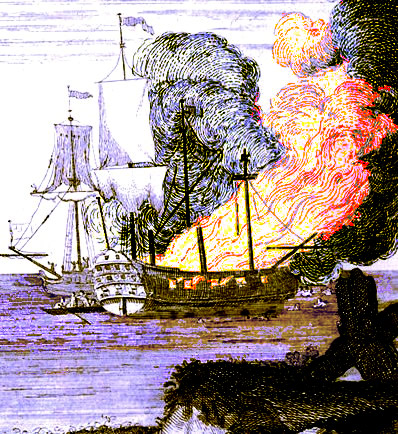
The Battle Between the Fancy and the Cassandra, From The General History
of
the Lives and Adventures of the Most Famous Highwaymen Murders Robbers
&c. (1736)
"At Sea, those wounded into the Brain, die soon after, we having no conveniency of lodging them or dressing them so warm as they require." (Richard Wiseman, "Of Wounds of the Brain," Severall Chirurgicall Treatises, p. 403)
Not every seaman who received a head wound died. After a long and losing battle with pirate Edward England off the Island of Comoros, East India Captain James Macrae grounded his ship and escaped on land. He reported, "I, with a few of my People, made what haste I could to the King’s Town, twenty five Miles from us, where I arrived next day, almost dead with Fatigue and Loss of Blood, having been sorely wounded in the Head by a Musket Ball."2 Although the specifics of his treatment are not mentioned, it is elsewhere noted that "10 Days after when he was pretty well recover’d"3. So treatment was possible, although it is notable that Macrae's treatment would have taken place on land.
After amputation, the operation many people think of when they consider sea surgery during the age of sail is trepanning - the act of drilling a hole in the skull to relieve the pressure on the brain of a man who has been struck in the head. Like amputation, trepanning (variously referred by a variety of names including trephining, trefining and trapanning in golden age of piracy surgical texts) was considered a capital operation due to the high rate of mortality of the patients. ('Capital' here referring to "deadly"1.) The act of trepanning
Artist: Hieronymus Bosch
Making Incision in the Skull , From "The Stone Cutting" (14th century) the skull is one of the few operations that can be proven to reach farther back than recorded history. It has continued to be a surgical procedure to this very day. However, it was not the only operation performed to treat skull trauma during this period.
This article begins with a very brief look at the pre-history of skull surgery. It then provides some information on the causes of skull wounds and fractures at sea from golden age of piracy accounts. Because skull fractures were not always obvious, we examine the symptoms a patient might exhibit when his skull has been fractured and the types of wounds that a sailor might receive. A brief discussion of the theory of when trepanning should be performed is discussed, with a minor discussion on how astrology was thought to impact the operation by some period surgeons.
From there, we discuss how various operations for a fractured skull would be performed. We begin with a variety of pre-operative procedures which include the administration of alcohol to ease the patient's distress, shaving the head in preparation for further surgical work, searching for a fracture, treating wounds that resulted from the trauma in the period before surgery was performed, bleeding the patient to prepare the bodily humors for surgery and the method for removing any foreign objects from the wound for the comfort of the patient.
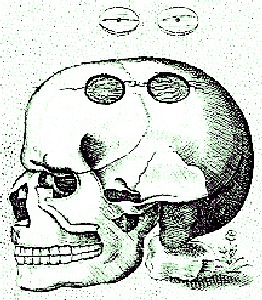
Skull Showing Trepanned Holes, From Les Ouvres
des Johannes
Scultetus (1598)
Next we look at treatments performed on fractured skulls which did not require trepanning. These include the way humoral treatments designed to balance the bodily fluids or remove the "bad" humors were performed, rasping a fracture to prevent it from impinging on the brain matter, dressing a rasped bone and raising a depressed portion of skull using elevators.
From there, the article will focus on the various aspects of trepanning, beginning with how the surgeon would prepare for the operation - practicing, readying both the patient and the site to be trepanned and choosing the location where the hole was to be made. Next the operation will be detailed, with in depth discussions on avoiding damage to the brain, intentionally piercing the brain in particular circumstances, cooling and cleaning the trepan as it is being used to cut, removing the circular bone fragment, cleaning up the trepanned hole and raising the skull using that hole. A couple of post-operative procedures will then be discussed including dressing the membrane and healing the trepanned site.
Finally post-operative procedures common to both trepanned and non-trepanned sites will be discussed. This will include treating wounds of the head, healing the incision made to search for the fracture, humor-based procedures, the way treatments were performed on the days following a skull operation and exfoliation (casting off of the dead sections) of the exposed bone.
A large variety of tools were used during the golden age of piracy when operating on skull fractures which will be be mentioned in this article. These tools are discussed in detail in a companion article on head surgery tools. Rather than re-present the information here, sections from the companion piece will be linked to directly when a tool is first mentioned.
1 Elisha Coles, "Capital", An English Dictionary, 1717, not paginated; 2 Post Boy, 4-22-4-25-21, Issue 4954; 3 Weekly Journal or British Gazetteer, 4-22-21
The Discovery of Trepanned Skulls From the Neolithic Age
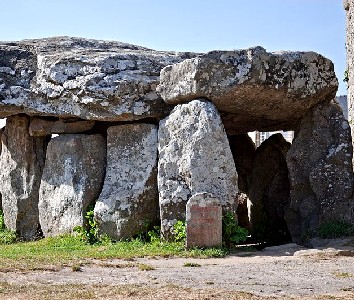
Photo: Wiki User Myrabella - Neolithic Dolmen in Brittany, France
Trepanning is one of the most ancient operations of which we know, dating to the Neolithic age (about 10,200 BC - 2000 BC) based on archeological evidence. The story of the recognition of skull trepanning as being such an ancient operation is rather interesting. It began in Marvejols (modern day Lozère in southern France) in the late 1860s and early 1870s, courtesy of physician and amateur anthropologist Barthélémy Prunières.
He appears to have first discovered "a cranium from which an enormous portion had been intentionally removed, the artificial character of this operation being clearly indicated by marks of cutting and sawing all round the margin, except on one small portion which looked as if it had been polished by friction of some kind" in a dolmen (tomb) near Aiguières in 1865.1 At the time, he thought it might have been used as a drinking cup by 'savage races' from pre-history.
Dr. Prunières later discovered another human skull with an oval piece of bone inside of it. The piece of bone was "two inches long by one and a half broad, artificially made from the parietal bone of a human skull. The two surfaces of this 'rondelle' were natural, but its surrounding margin was
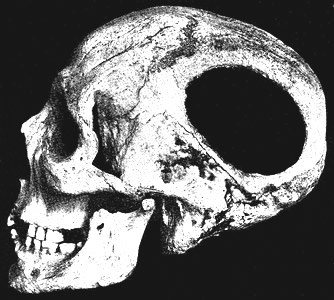
Trepanned Neolithic Skull Found in the Cave of Nogert-les-Vierges in
France, From the Wellcome Collection
bevelled at the expense of the upper surface and worked with care along its entire perimeter."2
Prunières presented this piece to the French Association for the Advancement of Science in August, 1873 in Lyon. It created a stir amongst the assembled. Because the 'rondelle' was not the same size or type of bone as the hole in the skull, Prunières said he was puzzled by the purpose of such a worked piece found inside of another skull. Thinking about similar pieces of bone he had seen in his amateur explorations, he suggested it may have been some sort of amulet.
On returning home, Prunières collected a number of similar pieces of bone and skulls with pieces cut out of them from the local dolmens. Using these pieces as examples he wrote a memoir which was presented to the Anthropological Society of Paris in March of 1874, again suggesting that these pieces of bone were the work of ancient amulet makers.
Around the same time, Dr. Paul Broca was invited by Baron de Baye to visit rectangular chambers cut out of soft chalk in the valley of Petit-Morin (Marne in north-eastern France), where the Baron showed him a variety of bones, including a 'rondelle' which "was at once recognized as analogous to the one exhibited at Lyon" by Dr. Prunières in 1873.3
When back in Paris, Dr. Broca examined the specimens sent to the Anthropological Society by Dr. Prunières where he noticed that what Prunières had been calling 'polished' parts of the amulets were actually "due to cicatricial deposits,
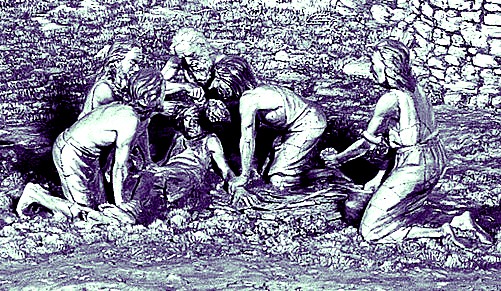
Neolithic Trepanning Concept Diorama From the Wellcome Trust
the result of a pathological action in the living body."4 From these signs of healing, he realized that the hole in the skull was a surgical trepanning and that the patient had remained alive afterwards, while the 'rondelle' was a result of a post-mortem trepanning.
Dr. Broca's conclusions cause intensified research by French archeologists into the various skulls and 'rondelles' that had been discovered previously. The Conservator of the Prehistoric Museum at Niort, France, published a brochure suggesting that a skull with a hole found in 1840 in Deux-Sèvres was not caused by a battle wound as originally thought, but was another case of pre-historic trepanning.
Dr. Broca summarized and reviewed such findings at the International Congress of Anthropology and Prehistoric Archaeology in September, 1876. The international publicity resulted in similar findings from all over Europe. "Skulls, showing undoubted evidence of having been subjected to the operation of trepanning during life, are found among dolichocephalic ['long-skull'] and brachycephalic ['broad, short-skull'] races, while their chronological range embraces all phases of European civilization, from the earliest Neolithic period down to the dawn of historic times."5
Many such skulls were discovered during this period. Dr. Prunières' collection alone contained 167 specimens of perforated skulls or fragments of such skulls.6
1 Dr. Robert Munro, “Prehistoric Trepanning and Cranial Amulets”, Eclectic Magazine of Foreign Literature, Science and Art, April 1893, p. 449; 2 Munro, p. 448; 3 Munro, p. 449; 4 Munro, p. 450; 5 Munro, p. 450-1; 6 Munro, p. 451
Causes of Skull Fractures

Hippocrates
The particular causes of skull fractures were many and varied, although all involved blows to the skull. Hippocrates is one of the first authors credited with observations on skull fractures from the book On Injuries of the Head. This is purported to have been written around 400 BC by him and/or his students. Educated physicians and surgeons during the golden age of piracy would have been familiar with Hippocrates' work; he is often cited in surgical books from the period.
The causes of skull fractures will not seem surprising, although it is notable that they were well understood in ancient history. For example, Hippocrates' book explains that someone "who falls from a very high place upon a very hard and blunt object is in most danger of sustaining a fracture and contusion of the bone, and of having it depressed from its natural position"1. He also notes that when a person has been struck in the head with a weapon, sometimes even in a minor way, he "will sustain a much greater injury, provided he has received the blow at the sutures [of the skull], than if it was elsewhere."2
Several accounts from the golden age of piracy discuss the types of head wounds that military and sea surgeons faced. Echoing Hippocrates, military surgeon Richard Wiseman explained that when someone's skull was "hurt by a sharp cutting Weapon, it cannot be without Solution of continuity in the Hairy scalp, but by a Fall or Blow the Scull may be fissured or fractured, and the Hairy scalp whole, and this Fracture or Fissure may be under the Contusion, or in some other Parts."3 Wiseman described a situation Hippocrates could not have foretold where a soldier "was brought to us shot with a Musket-bullet on the right side of his Head. My servant William Clark... in dressing his Wound felt the Shot sticking deep in the Scull."4
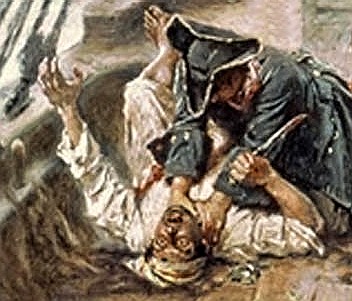
Artist: Jean Leon Gerome Ferris
An Engagement or Simply a Disagreement? (1920)
Sea surgeon John Moyle described a variety of head wounds that sailors received at sea in his Memoirs. In a skull wound worthy of a pirate, a 34 year old mariner received a "Violent Stroke with an Iron Crow (in Boarding of the Enemy) to receive a considerable Wound on the Mesocraneum [the middle of the skull], with a large Fracture in the Skull, and a Læsure of the Dura Meninx [leisure in the dura mater or outer membrane of the brain under the skull]."5
Sometimes it wasn't a battle wound that caused fracturing of the skull. Men kept cooped up together in a ship were likely to have disagreements as one of Moyle's accounts suggests. "Two of the Gun-room Crew falling out, the one hapned to receive an unlucky Blow on the Head with a Hand-spike; insomuch as there was great Contusion and Laniation [tearing the skin to pieces] by the Claw of the Hand-spike; which also bruised the Skull, and made a small Fracture or Fissure through the first Table; it was on the upper Part of the Frontal Bone."6
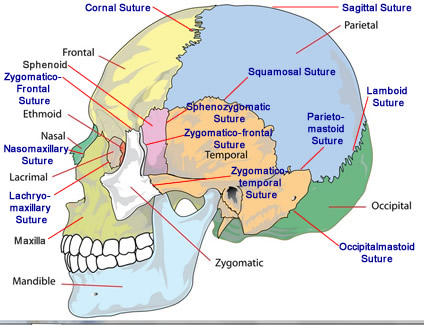
The Bones and Sutures of the Skull
Head wounds could also be caused by accidents. A sailor "hapned by a Fall off the Forecastle, and his Head hitting against the Windlise [windlass - a mechanical hoisting mechanism]; to receive a large depression of the Skull, with a considerable Fissure about an Inch and a half long through both Tables [of the skull - the skull has two 'tables' of bone - an inner and outer layer separated by a spongy layer called the diploe]. The depression was in the Occipital Bone, close to the Labdoides [Lamboid] suture, (for he fell backward. The Fissure was extended from that Depression and Suture, upward along the Left side of the Sagital Suture [the suture along the center of the skull]. The Wound was but small, but the Contusion great."7
In another case, apparently of overenthusiasm, "A Young Sailor running hastily in at the Steerage door, and hitting his Head violently against a cross Beam, was struck down backward, and receiv'd a severe Bruise on the Sinciput [the front of the skull from the forehead to the crown], near the Coronal Suture; but no Wound, nor yet sensible Signs of a Fracture."8
This is obviously not the extent of the types of head injuries that could occur at sea, but it does provide a nice overview of some of them.
1 Hippocrates, On Injuries of the Head, Translated and Edited by Francis Adams, p. 454; 2 Hippocrates, p. 456; 3 Richard Wiseman, Of Wounds, Severall Chirurgicall Treatises, 1676, p. 379; 4 Wiseman, p. 401-2; 5 John Moyle, Memoirs: Of many Extraordinary Cures, 1708, p. 1; 6 Moyle, p. 22; 7 Moyle, p. 11-2; 8 Moyle, p. 18

